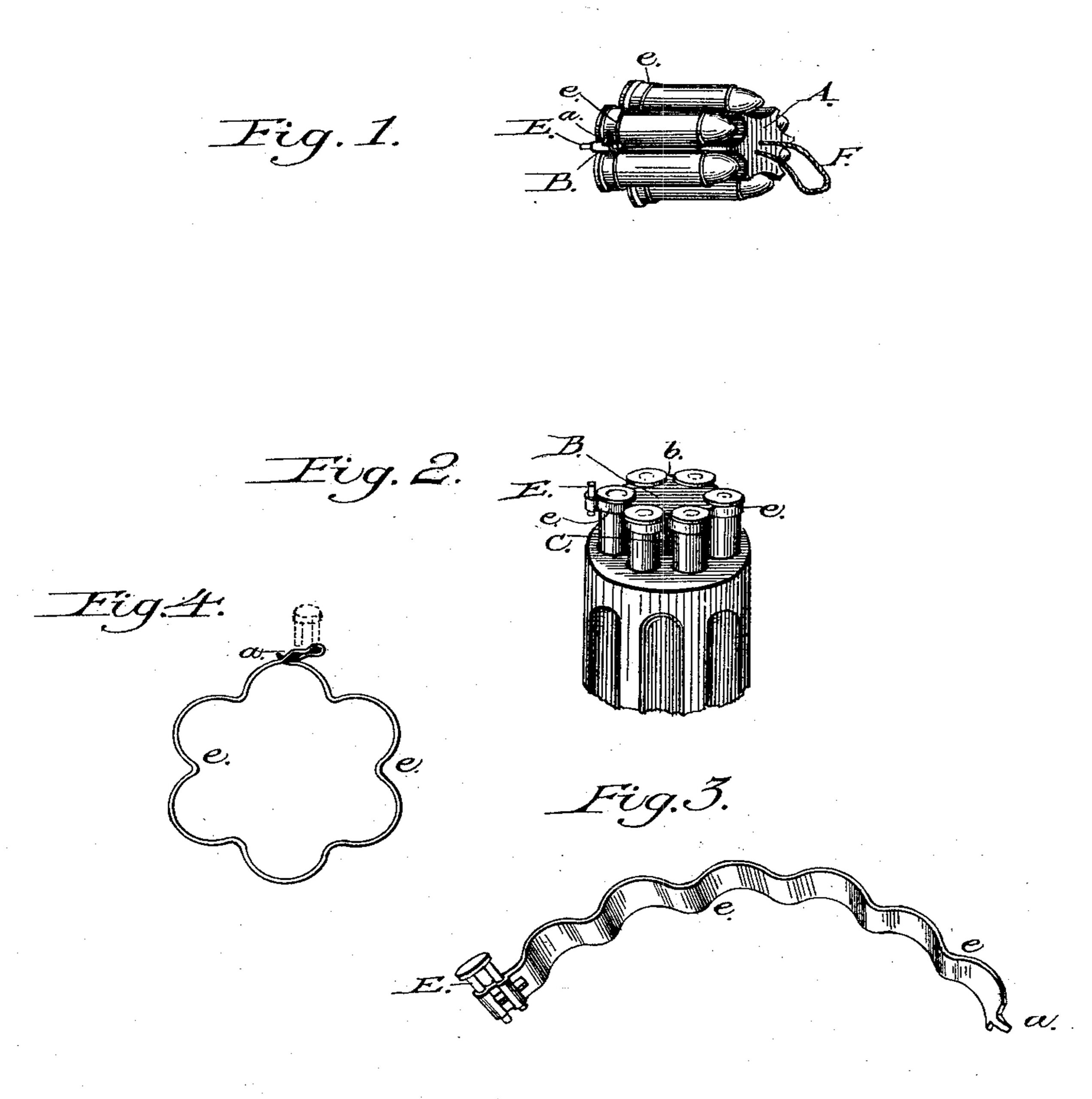US 394374
UNITED STATES PATENT OFFICE.
JOHN C. KELTON, OF WASHINGTON, DISTRICT OF COLUMBIA.
CARTRIDGE-FEED PACK.
SPECIFICATION forming part of Letters Patent No. 394,374, dated December 11, 1888.
Application filed January 11,1887, Renewed May 9, 1888. Serial No. 273,360. (No model.)
To all whom it may concern:
Be it known that I, JOHN C. KELTON, of the city of Washington, District of Columbia, have invented an Improvement in Pistol-Cartridge Packs; and I hereby declare the following to be a full, clear, and exact description of the same.
My invention relates to a means for rapidly reloading the chambers of revolvers; and it consists of cartridges secured together so as to be in line with the chambers of the revolver, into which they can all be instantly inserted and the holding device removed, and is an improvement on Patent No. 331 891, issued to me December 8, 1885.
Referring to the accompanying drawings for a more complete explanation of my invention, Figure 1 is a view showing the cartridges packed together ready for use. Fig. 2 shows them partially inserted into the chambers of the revolver. Fig. 3 shows a spring-band detached and open. Fig. 4 is a modification to be referred to.
This pack affords a means by which all the chambers of the Smith & Wesson and similarly-constructed pistols can be loaded simultaneously.
A and B are two parts of a core, which is grooved or chambered so that the cartridges may be assembled around it at such distances that they will stand nearly in line with the chambers of the revolver when placed opposite to them. Alongside of the upper or rear end of the shouldered portion B of the core, and unattached thereto, is placed a pin, E, to which is secured one end of a very thin metal spring-band, e, preferably corrugated, the band being passed around the assembled cartridges and. the ends being locked, latched, or bolted together in any convenient manner to bind and securely hold them together in such a manner that they may be instantly liberated by a pressure against the pin E.
In Fig. 3 I have shown a spring-band provided with a small hook, a, which, when the band is secured in position, as shown in Figs. 1 and 2, hooks under and partially around the pin E.
It is evident that by pressing the pin E outward the hook a is unfastened and spring-band is instantly released and the cartridges liberated.
I do not limit myself to any particular manner of securing the spring-band, as it is evident that this may be greatly varied without departing from the spirit of my present invention.
The cartridges are put up in packages of this description at the armory or other convenient place, and may be surrounded by an envelope of paper or wood, or otherwise packed for transportation and protection until ready for use. The inclosing case is readily drawn off or removed when the pistol is to be charged.
The lower part, A, of the core, as well as the lower part of the envelope, is drawn away by means of a loop, F, which is attached to it, as described, in my former patent. The ends of the cartridges are then inserted into the cylinder-chambers, being still held in position upon the shouldered portion of the core by the spring-band which is around them. When the central pin, C, of the core strikes the end of the cylinder, the spring-band is released, and the top part, B, of the core (which has beveled edges b) is stopped, leaving the cartridges to fall into the chambers, after which the pistol may be closed. By this means the six chambers of the revolver may be loaded in a few seconds.
The need of such a pack for certain and rapid reloading is absolutely necessary in war, and especially where the pistol is used in hand-to-hand combat, where success depends upon the rapidity with which the pistol can be reloaded and discharged.
I am aware that cartridge-packs are not broadly new, and I do not claim such as my invention.
Having thus described my invention, what I do claim as new, and desire to secure by Letters Patent, is—
A corrugated metallic band and a mechanism for holding and releasing the same, in combination with an internal core, substantially as and for the purpose herein set forth.
JOHN C. KELTON,
Witnesses:
W. H. PATTERSON,
D. S. CLARK.

